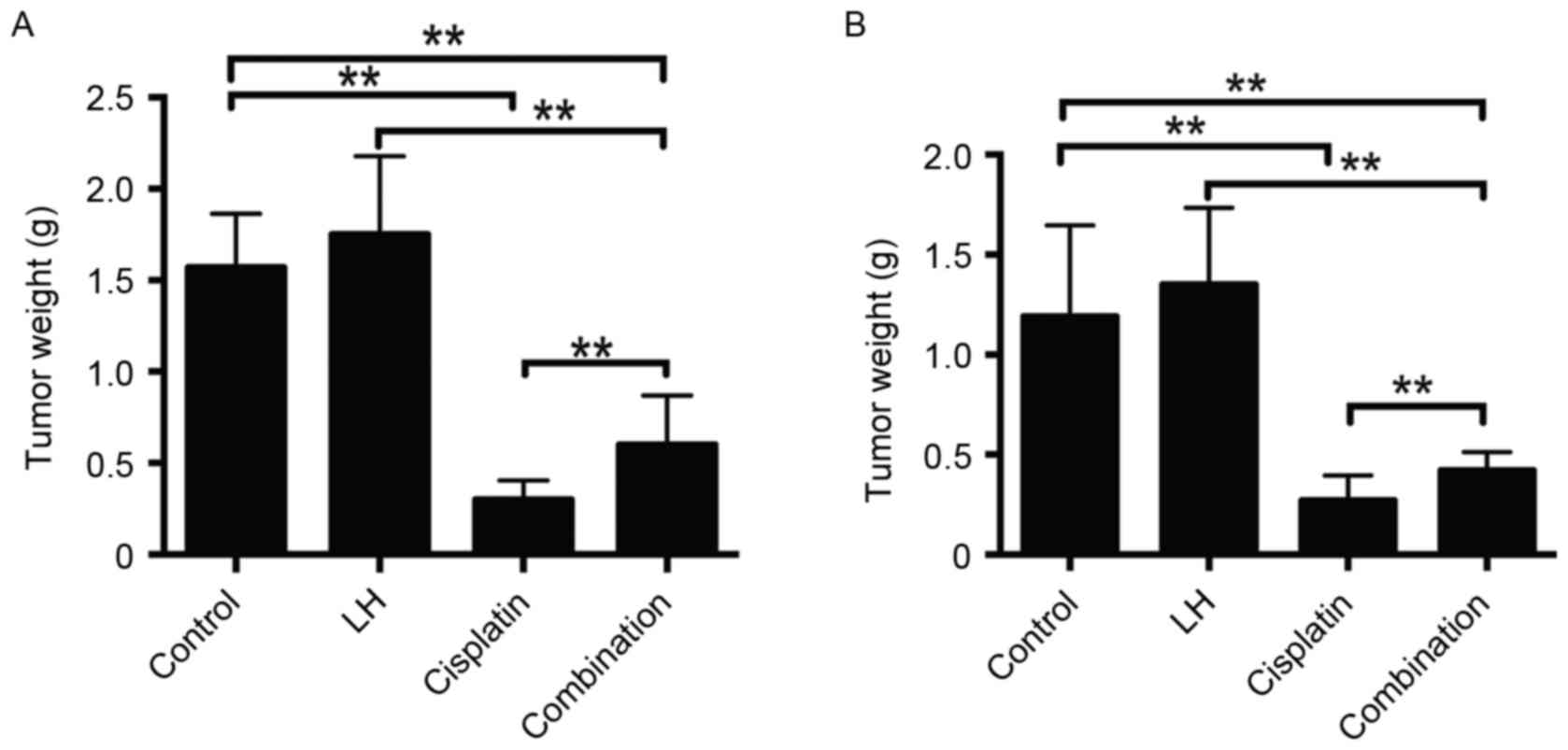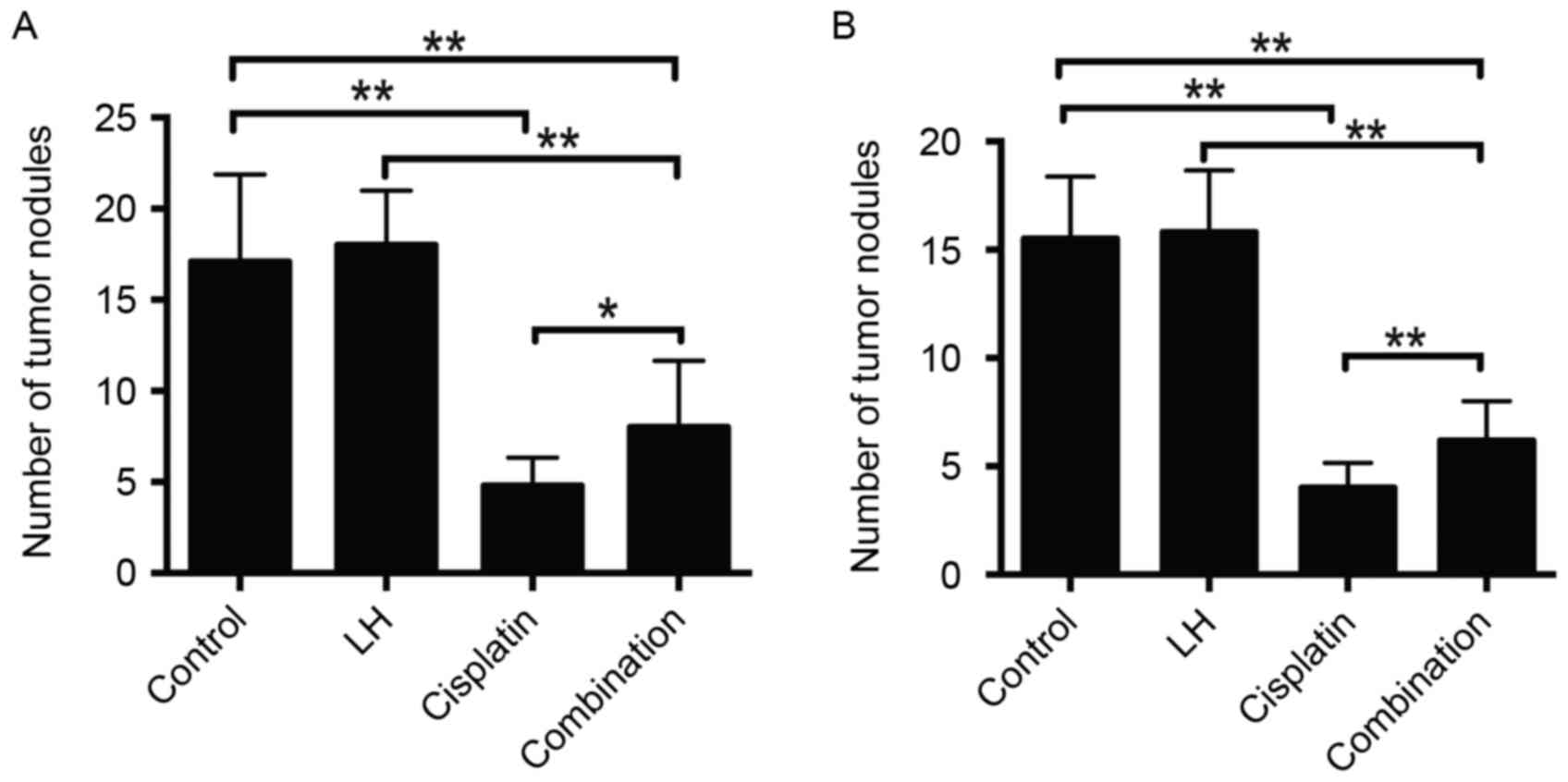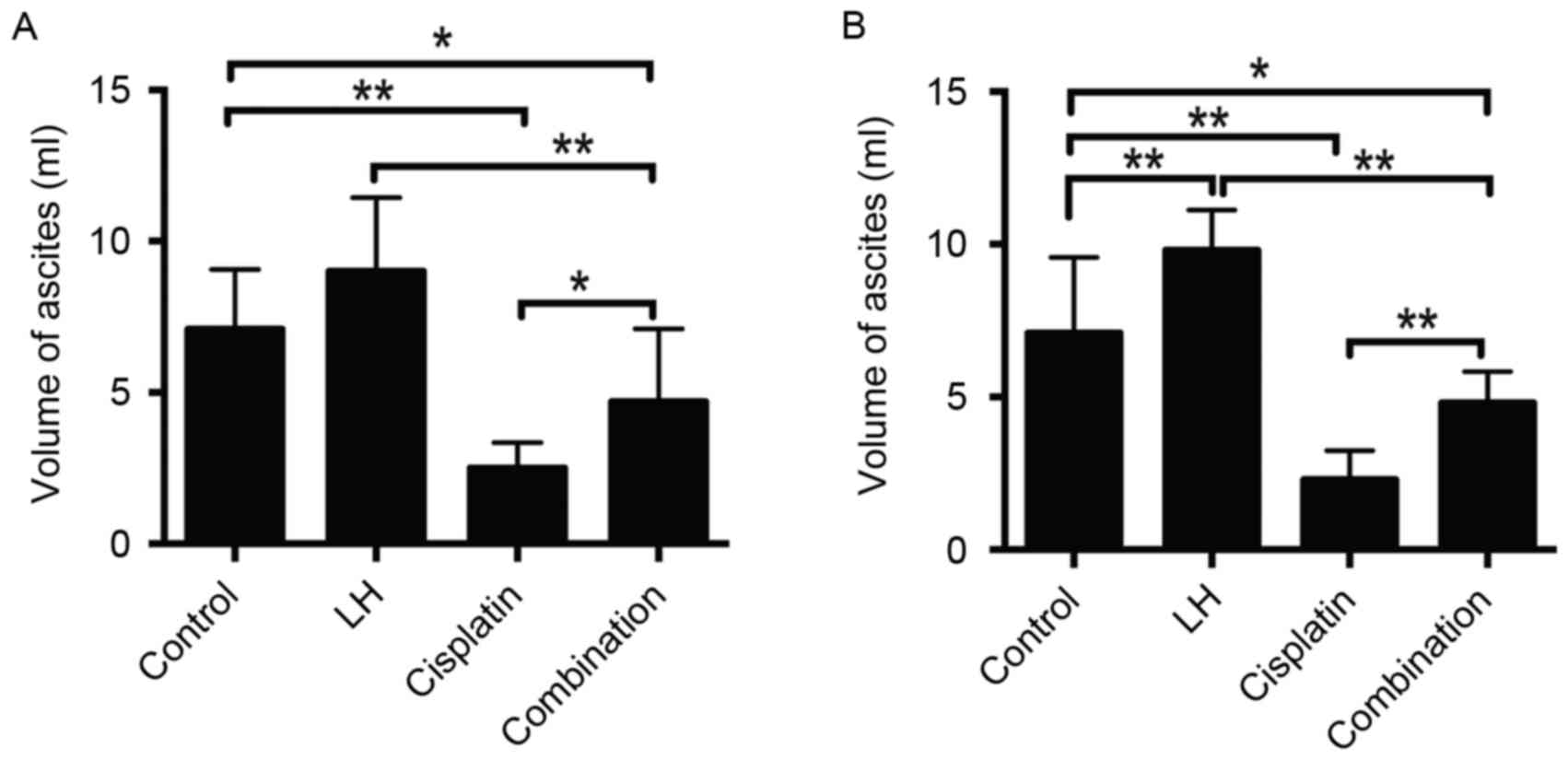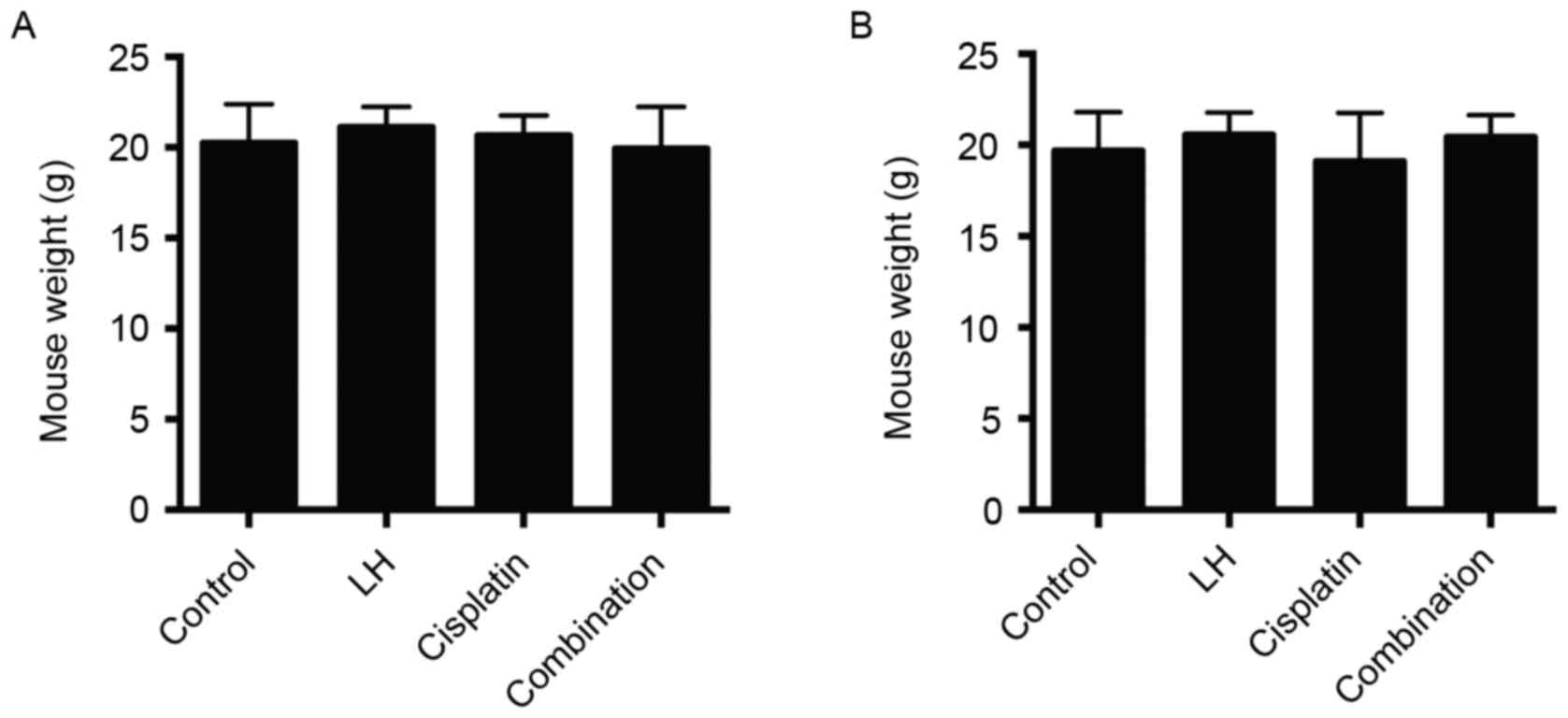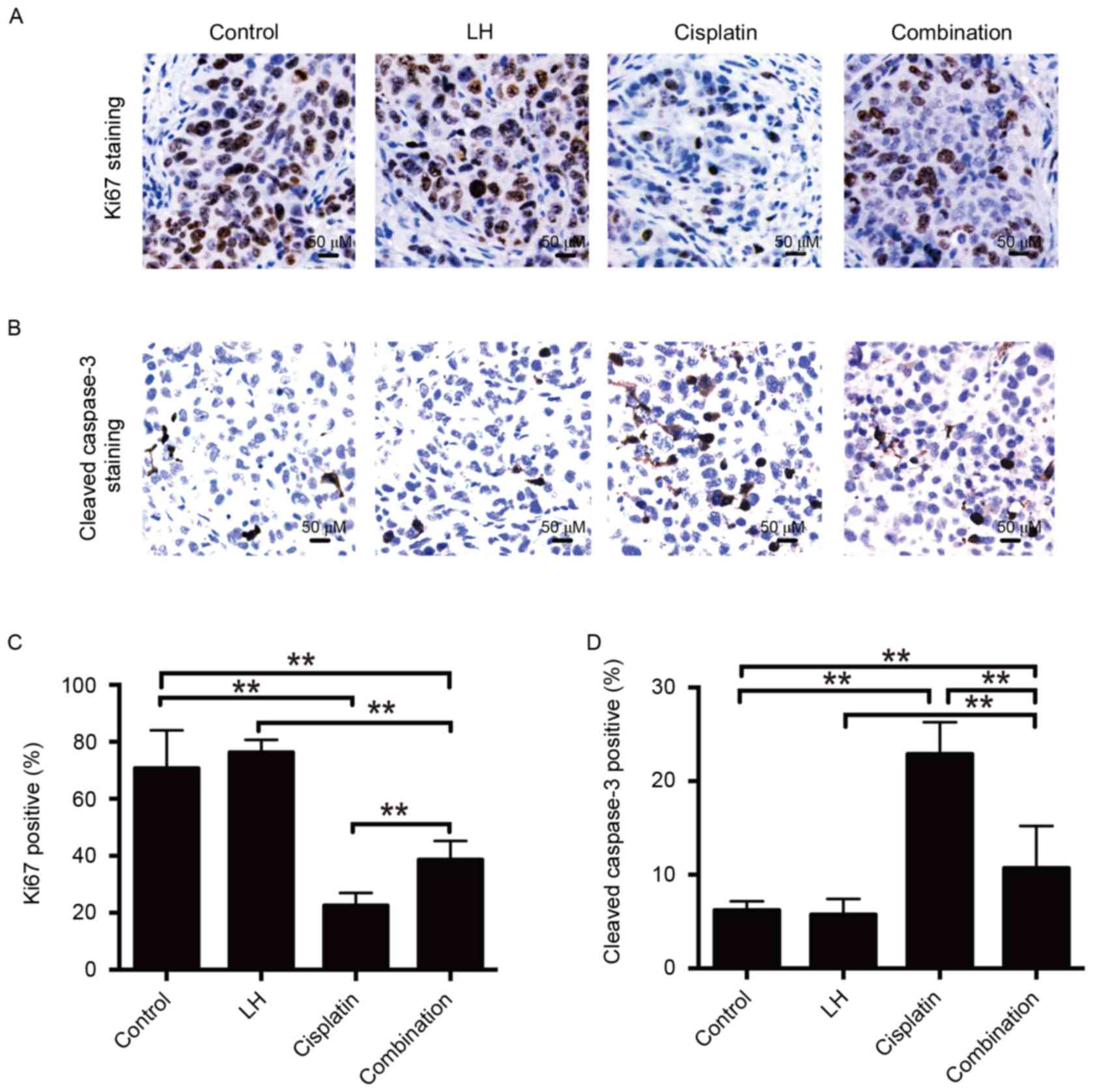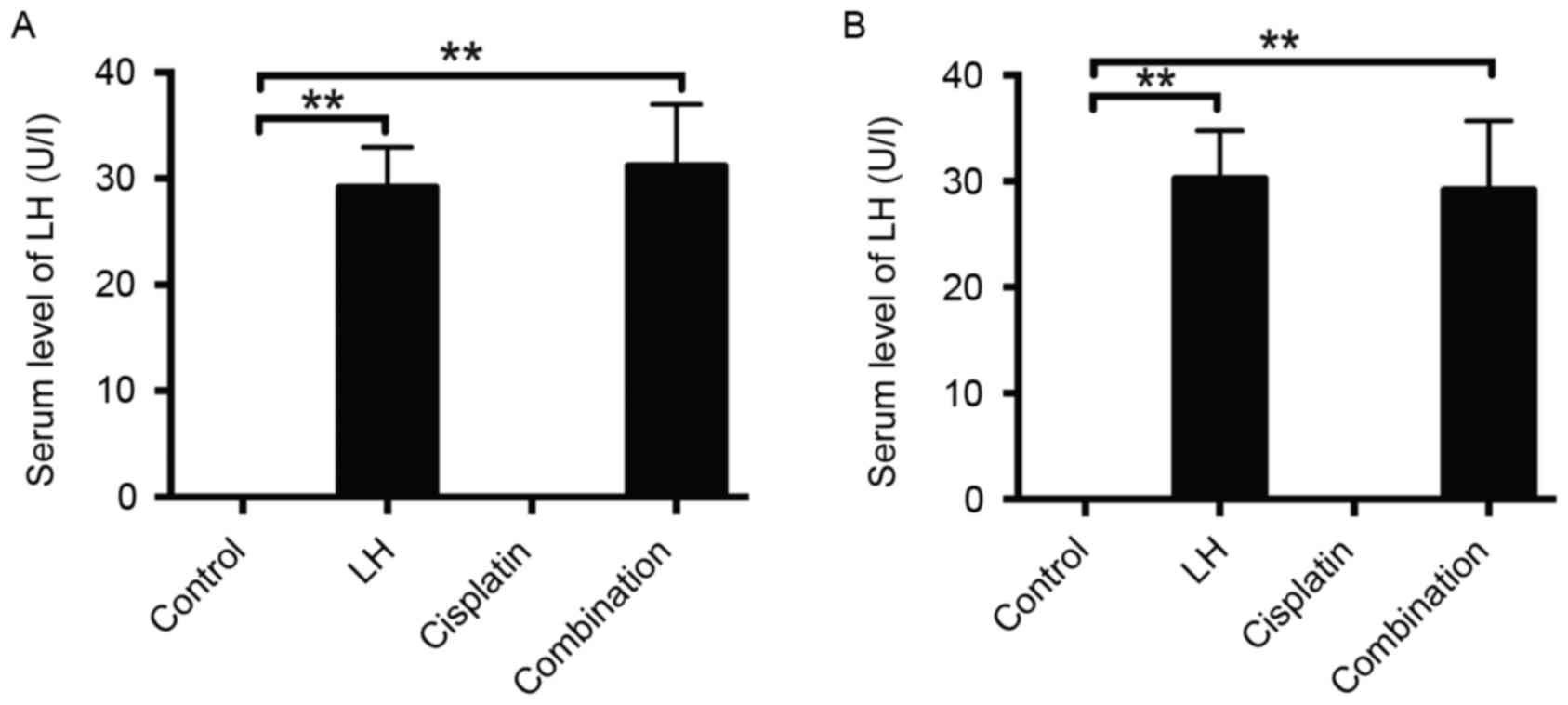Luteinizing hormone compromises the in vivo anti-tumor effect of cisplatin on human epithelial ovarian cancer cells
- Authors:
- Published online on: December 19, 2017 https://doi.org/10.3892/ol.2017.7655
- Pages: 3141-3146
Abstract
Introduction
Ovarian cancer is often diagnosed when it is at an advanced stage. The overall 5-year survival rate of patients with ovarian cancer is ~40% (1) and ovarian cancer is one of the leading causes of gynecological cancer-related mortality. The exact cause of epithelial ovarian cancer has not yet been determined. It has been suggested that gonadotropins, including follicle-stimulating hormone (FSH) and luteinizing hormone (LH) serve an important role in the development of ovarian cancer (2), although their underlying mechanisms of action remain unknown (3). Ovarian epithelial cancer is usually characterized by elevated levels of FSH and LH, particularly in post-menopausal women or in women receiving treatment to induce ovulation (4–7). Furthermore, the results of epidemiological studies have revealed that reduced exposure to, or lower levels of gonadotropins are associated with a decreased risk of ovarian cancer (4–7). Lower levels of gonadotropins may be induced following multiple pregnancies, breast-feeding, the use of oral contraceptives and during estrogen replacement therapy (8,9). Compared with FSH, the effect of LH on ovarian cancer is contentious. It has been reported that there is no association between LH and ovarian cancer cell proliferation (10); furthermore, studies have demonstrated that LH may inhibit or stimulate the progression of ovarian cancer (11–16).
Cisplatin has been widely used to treat various solid malignancies, including ovarian cancer, with a consistent rate of initial responses (17). Following the binding of cisplatin to DNA, unrepairable DNA lesions are generated, the DNA damage response is activated and mitochondrial apoptosis or proliferative arrest is subsequently induced (17). However, resistance to cisplatin readily develops and this may compromise its anti-tumor effect, resulting in therapeutic failure (17). Therefore, it is important to understand the underlying mechanisms of cisplatin resistance. It has been demonstrated that the development of cisplatin resistance is a complicated process that arises at diverse stages of DNA-targeting (17).
LH may inhibit cisplatin-induced apoptosis in vitro (18). Therefore, the present study used epithelial ovarian cancer cells to determine whether LH impairs the in vivo anti-tumor effect of cisplatin in xenograft nude mice, at least in part, by inhibiting the pro-apoptotic activity of cisplatin.
Materials and methods
Reagents and antibodies
LH was purchased from Merck KGaA (Darmstadt, Germany) and cisplatin was purchased from Selleck Chemicals LLC. (Houston, TX, USA). The antibodies used in the immunohistochemistry assay were anti-ki67 (cat. no. MA5-14520; Neomarkers, Inc., Waltham, MA, USA) and anti-cleaved caspase-3 (cat. no. 9661S; Cell Signaling Technology, Inc., Danvers, MA, USA).
Cell lines and culture conditions
The highly metastatic human ovarian cancer cell lines, HeyA8 and SKOV3ip1, were used as described previously (19). Cells were purchased from the MD Anderson Characterized Cell Line Core Facility (Houston, TX, USA). Cells were cultured in RPMI 1640 medium supplemented with 10% fetal bovine serum (both purchased from Gibco; Thermo Fisher Scientific, Inc., Waltham, MA, USA) and 0.5% gentamicin, maintained on plastic and incubated at 37°C in a mixture of 5% CO2 and 95% air. Tumor cells were free of pathogenic murine viruses and mycoplasma. The cells were maintained at 37°C in a mixture of 5% CO2 and 95% air for <10 weeks following recovery from a frozen stock.
Animals
A total of 80 age-matched 8–10-week-old female athymic nude mice (NCr-nu) weighing 15.7–20.3 g were purchased from the Shanghai SLAC Laboratory Animal Co., Ltd. (Shanghai, China). The mice were housed under specific pathogen-free conditions at the animal facility of Shanghai Medical School, Fudan University (Shanghai, China). All mice were bred in a specific pathogen-free animal facility and were housed 4 per cage bedded with heat-treated chipped hardwood which was changed weekly. The facility used a 12 h light/dark cycle, and a standardized room temperature and humidity (30–70%). Sterile pelleted food and water were freely available. Animal care and experiments were approved by the Institutional Animal Care and Use Committee at Shanghai Medical School, Fudan University and all procedures complied with the Guide for the Care and Use of Laboratory Animals published by the US National Institutes of Health (20).
Orthotopic tumor implantation and treatment
Sub-confluent cultures of HeyA8 and SKOV3ip1 cells were harvested and suspended in Hank's balanced salt solution medium (Invitrogen; Thermo Fisher Scientific, Inc., Waltham, MA, USA). Cell viability was determined to be >95% using trypan blue exclusion (19). Suspended cells were intraperitoneally implanted into mice at a concentration of 2.5×105 cells/0.2 ml for HeyA8 cells or 1.0×106 cells/0.2 ml for SKOV3ip1 cells. The 40 mice were randomly divided into 4 groups (n=10/group) 7 days following tumor implantation. One group, which served as a control, received injections of PBS (equal volume, intraperitoneal, once a week), one group received LH alone (3 U/day, subcutaneous), one group received cisplatin alone (2.5 mg/kg/week, intraperitoneal) and one group received LH (3 U/day, subcutaneous) combined with cisplatin (2.5 mg/kg/week, intraperitoneal). It has been demonstrated that low-doses (3 U/day, subcutaneously) of FSH induce an improved effect compared with high-doses (10 U/day, subcutaneous) (21). Therefore, 3 U/day LH was administered to mice undergoing treatment with LH in the present study.
During tumor progression, mice in the control and LH groups became weaker and moribund. These mice exhibited increased tumor load, decreased food consumption, decreased activity, and increased size of the ascites. Most mice exhibited some of these symptoms, however, mice in the control and LH groups exhibited the most severe symptoms. Seeing as mice in these two groups did not receive cisplatin chemotherapy, this was in line with expectations (18). When most mice in the control and LH groups presented with symptoms and became moribund, all the mice in the experiment were sacrificed immediately. HeyA8-implanted mice were sacrificed following 3 weeks treatment and SKOVip1-implanted mice were sacrificed following 5 weeks treatment. Prior to sacrifice, mice underwent inhalation anesthesia with 2% isoflurane (Ruiwode Lifescience Co. Shenzhen, China.). Following collection of ~1 ml blood via a cardiac puncture under anesthesia, mice were sacrificed. Body and tumor weight and the number of tumor nodules were recorded. Additionally, ascites were collected, blood was collected via cardiac puncture and all other samples were collected following sacrifice of mice on day 28 for HeyA8-implanted mice and on day 42 for SKOVip1-implanted mice.
Prior to immunohistochemical (IHC) staining, tumor tissues were fixed in formalin (cat. no. 50-00-0; Sinopharm Chemical Reagent Co., Ltd., Shanghai, China) at room temperature for ≥24 h and embedded in paraffin. Tissues were then cut into 4-µM thick sections.
Measurement of serum LH levels
Blood samples were collected from the inferior vena cava and allowed to clot for 2 h at room temperature prior to centrifugation for 20 min at 2,000 × g. Sera were then collected for LH level measurements using a Luteinizing Hormone Human ELISA kit (cat. no. EHLH) (Thermo Fisher Scientific, Inc.).
IHC staining for ki67 and cleaved caspase-3
Paraffin sections were deparaffinized and rehydrated, then antigen retrieval was performed using EZ antigen retrieval 3 solution (BioGenex Laboratories, San Ramon, CA, USA). Sections were then blocked with 3% hydrogen peroxide in methanol and 4% fish gelatin at room temperature for 30 min. Sections were then incubated with rabbit anti-ki67 (1:200) or rabbit anti-cleaved caspase-3 (1:100) overnight at 4°C. Following washing with PBS, sections were incubated with horseradish peroxidase-conjugated goat anti-rabbit immunoglobulin G (cat. no. 111-005-045; dilution, 1:200; Jackson ImmunoResearch Laboratories, Inc., West Grove, PA, USA) for 60 min at room temperature. Sections were visualized with a 3,3′-diaminobenzidine kit (Vector Laboratories, Inc.), counterstained with hematoxylin at room temperature for 10 sec, dehydrated and mounted in Richard-Allan Scientific™ Cytoseal™ XYL (Thermo Fisher Scientific, Inc.). Antibody staining in the tissue sections was observed using a light microscope (×40 magnification).
The count of ki67- or cleaved caspase-3-positive cells was independently performed by two experienced pathologists. Briefly, each entire slide was evaluated and five fields were randomly visualized at a magnification of ×200. Subsequently, the average proportion of positively stained tumor cells was calculated based on the results from the five fields using ImageJ software (version 1.31; National Institutes of Health, Bethesda, MD, USA).
Statistical analysis
All data are presented as the mean ± standard error of the mean. For in vivo therapy experiments, 10 mice were used in each group, which enabled the detection of a 50% reduction in tumor size (ß error=0.2). Continuous variables were compared using two-tailed Student's t-tests (for 2 groups) or one-way analysis of variance followed by Tukey's test (>2 groups) if the data were normally distributed. For non-parametric distributions, the Mann-Whitney U or the Kruskal-Wallis test were used. P<0.05 was considered to indicate a statistically significant difference.
Results
LH impairs the in vivo anti-tumor effect of cisplatin
In the HeyA8- and SKOV3ip1- implanted mice, cisplatin alone but not LH alone treatment significantly reduced tumor weight and nodule number compared with the control group (Figs. 1 and 2). Although the treatment of cisplatin combined with LH still suppressed tumor weight and nodule number compared with the control group, the addition of LH significantly compromised the anti-tumor effect compared with cisplatin alone treatment (Figs. 1 and 2).
The maximum total tumor weight in SKOV3ip1-implanted nude mice was 2.0 g and in HeyA8-implanted nude mice, it was 2.4 g. The maximum number of tumors in SKOV3ip1-implanted nude mice was 21 and that in HeyA8-implanted nude mice was 25. The longest diameter of a single tumor was ~1 cm.
The volume of ascites may also represent the orthotopic tumor growth of ovarian cancer (22). The maximum volume of ascites observed in the current study was 12 ml. Treatment with cisplatin alone significantly reduced the volume of ascites compared with the control group in HeyA8- and SKOV3ip1-implanted nude mice (Fig. 3). Additionally, treatment with LH alone slightly increased the volume of ascites in HeyA8-implanted mice (Fig. 3A) and significantly increased the volume of ascites in SKOV3ip1-implanted mice (Fig. 3B). Combined treatment of cisplatin with LH significantly impaired the anti-tumor effect of cisplatin, indicated by the significant increase of ascite volume in the group receiving combination treatment compared with the group receiving treatment with cisplatin alone (Fig. 3). In addition, no differences were in mouse weights were observed among all four groups (Fig. 4). These results indicate that LH may impair the in vivo anti-tumor effect of cisplatin in nude mice implanted with epithelial ovarian cancer cells.
LH compromises the pro-apoptotic effect of cisplatin
The nuclear protein ki67 has been used as a biomarker for cell proliferation (23). Staining of proliferative and apoptotic cells and the quantitative analysis are depicted in Fig. 5. It was observed that the number of ki67-positive cells was significantly decreased in the cisplatin and combination treatment groups compared with the control group in SKOV3ip1-implanted mice (Fig. 5C). No significant differences were observed between the LH and control groups. Furthermore, combination treatment with cisplatin and LH resulted in increased ki67 expression compared to treatment with cisplatin alone (Fig. 5A and C), indicating that LH may compromise the anti-tumor activity of cisplatin.
Apoptosis is primary mechanism by which cisplatin induces cell death (24). Therefore, the current study investigated whether the impairment of cisplatin anti-tumor activity by LH results from the inhibition of LH on the cisplatin-mediated pro-apoptotic effect. The results of IHC staining demonstrated that combination treatment of cisplatin and LH led to fewer apoptotic cells determined by staining for cleaved caspase-3, compared with the group treated with cisplatin alone. However, combination treatment still induced more apoptosis than the control group (Fig. 5B and D). No significant differences were identified between the LH and control groups. These results indicate that LH impairs the in vivo anti-tumor effect of cisplatin, at least in part, by inhibiting the pro-apoptotic activity of cisplatin.
Serum levels of LH in the xenografted nude mice
In order to confirm the validity of the LH injection, the serum levels of LH were measured. As expected, LH was undetectable in the sera of control and cisplatin-treated mice, whereas the concentration of LH in the mouse sera of the groups treated with LH alone or LH combined with cisplatin was ~30 U/l in the HeyA8- and SKOV3ip1-implanted mice (Fig. 6).
Discussion
Ovarian cancer often occurs in postmenopausal women and is characterized by high gonadotropin levels (~40 U/l). Therefore, gonadotropins including FSH and LH have been regarded as probable risk factors for the development of ovarian cancer. FSH has been identified to serve a function in the development and progression of ovarian cancer in vitro and in vivo (21,25). However, previous studies have identified that LH is able to inhibit apoptosis and facilitate angiogenesis in vitro (26–28), and therefore the effect of LH in vivo is worth investigating.
In the present study, two epithelial ovarian cancer cell lines, HeyA8 and SKOV3ip1, were implanted into nude mice and the effect of exogenous LH was detected on the cisplatin anti-tumor activity. ELISA was employed to verify the LH serum level ~30 U/l in mice treated with LH, which is comparable to the LH level in patients with post-menopausal ovarian cancer (29). Cisplatin is capable of inducing apoptosis in ovarian cancer cells (30,31). In the present study, cisplatin significantly inhibited the growth of ovarian tumors, number of tumor nodules and volume of ascites. In addition, it was revealed that treatment with LH alone exhibited a minimal effect on tumor weights and the number of tumor nodules, although it increased the volumes of ascites. The in vivo anti-tumor effect of cisplatin was significantly impaired when administered in combination with LH, which was determined by the increase of growth of ovarian tumors, the number of tumor nodules and the volume of ascites compared with the group that underwent treatment with cisplatin alone.
It was observed that the number of apoptotic cells with cleaved caspase-3-positive was significantly reduced following combination treatment with LH and cisplatin, and that the number of proliferative cells with ki67-positive was increased compared with the group that received treatment with cisplatin alone. However, the present study did not investigate the underlying antitumor mechanisms responsible for the effect of LH on impairing cisplatin in vivo.
Collectively, results of the present study indicate that LH weakens the anti-tumor effect of cisplatin in vivo, and LH may contribute to the development of drug resistance to cisplatin in ovarian cancer. LH-antagonists may be used in the near future to reverse the effect of LH and to aid in the treatment of ovarian cancer (32).
References
|
Siegel RL, Miller KD and Jemal A: Cancer statistics, 2016. CA Cancer J Clin. 66:7–30. 2016. View Article : Google Scholar : PubMed/NCBI | |
|
Stadel BV: Letter: The etiology and prevention of ovarian cancer. Am J Obstet Gynecol. 123:772–774. 1975. View Article : Google Scholar : PubMed/NCBI | |
|
Mertens-Walker I, Baxter RC and Marsh DJ: Gonadotropin signalling in epithelial ovarian cancer. Cancer Lett. 324:152–159. 2012. View Article : Google Scholar : PubMed/NCBI | |
|
Venn A, Watson L, Bruinsma F, Giles G and Healy D: Risk of cancer after use of fertility drugs with in-vitro fertilisation. Lancet. 354:1586–1590. 1999. View Article : Google Scholar : PubMed/NCBI | |
|
Brekelmans CT: Risk factors and risk reduction of breast and ovarian cancer. Curr Opin Obstet Gynecol. 15:63–68. 2003. View Article : Google Scholar : PubMed/NCBI | |
|
Holschneider CH and Berek JS: Ovarian cancer: Epidemiology, biology, and prognostic factors. Semin Surg Oncol. 19:3–10. 2000. View Article : Google Scholar : PubMed/NCBI | |
|
Tavani A, Ricci E, La Vecchia C, Surace M, Benzi G, Parazzini F and Franceschi S: Influence of menstrual and reproductive factors on ovarian cancer risk in women with and without family history of breast or ovarian cancer. Int J Epidemiol. 29:799–802. 2000. View Article : Google Scholar : PubMed/NCBI | |
|
Daly M and Obrams GI: Epidemiology and risk assessment for ovarian cancer. Semin Oncol. 25:255–264. 1998.PubMed/NCBI | |
|
Gnagy S, Ming EE, Devesa SS, Hartge P and Whittemore AS: Declining ovarian cancer rates in U.S. women in relation to parity and oral contraceptive use. Epidemiology. 11:102–105. 2000. View Article : Google Scholar : PubMed/NCBI | |
|
Zheng W, Lu JJ, Luo F, Zheng Y, Feng Yj, Felix JC, Lauchlan SC and Pike MC: Ovarian epithelial tumor growth promotion by follicle-stimulating hormone and inhibition of the effect by luteinizing hormone. Gynecol Oncol. 76:80–88. 2000. View Article : Google Scholar : PubMed/NCBI | |
|
Kurbacher CM, Jäger W, Kurbacher JA, Bittl A, Wildt L and Lang N: Influence of human luteinizing hormone on cell growth and CA 125 secretion of primary epithelial ovarian carcinomas in vitro. Tumour Biol. 16:374–384. 1995. View Article : Google Scholar : PubMed/NCBI | |
|
Kuroda H, Mandai M, Konishi I, Yura Y, Tsuruta Y, Hamid AA, Nanbu K, Matsushita K and Mori T: Human chorionic gonadotropin (hCG) inhibits cisplatin-induced apoptosis in ovarian cancer cells: Possible role of up-regulation of insulin-like growth factor-1 by hCG. Int J Cancer. 76:571–578. 1998. View Article : Google Scholar : PubMed/NCBI | |
|
Tashiro H, Miyazaki K, Okamura H, Iwai A and Fukumoto M: c-myc over-expression in human primary ovarian tumours: Its relevance to tumour progression. Int J Cancer. 50:828–833. 1992. View Article : Google Scholar : PubMed/NCBI | |
|
Tourgeman DE, Lu JJ, Boostanfar R, Amezcua C, Felix JC and Paulson RJ: Human chorionic gonadotropin suppresses ovarian epithelial neoplastic cell proliferation in vitro. Fertil Steril. 78:1096–1099. 2002. View Article : Google Scholar : PubMed/NCBI | |
|
Choi JH, Choi KC, Auersperg N and Leung PC: Gonadotropins activate proteolysis and increase invasion through protein kinase A and phosphatidylinositol 3-kinase pathways in human epithelial ovarian cancer cells. Cancer Res. 66:3912–3920. 2006. View Article : Google Scholar : PubMed/NCBI | |
|
Tilly JL, Tilly KI, Kenton ML and Johnson AL: Expression of members of the bcl-2 gene family in the immature rat ovary: Equine chorionic gonadotropin-mediated inhibition of granulosa cell apoptosis is associated with decreased bax and constitutive bcl-2 and bcl-xlong messenger ribonucleic acid levels. Endocrinology. 136:232–241. 1995. View Article : Google Scholar : PubMed/NCBI | |
|
Galluzzi L, Senovilla L, Vitale I, Michels J, Martins I, Kepp O, Castedo M and Kroemer G: Molecular mechanisms of cisplatin resistance. Oncogene. 31:1869–1883. 2012. View Article : Google Scholar : PubMed/NCBI | |
|
Xia L, Wen H, Han X, Tang J and Huang Y: Luteinizing hormone inhibits cisplatin-induced apoptosis in human epithelial ovarian cancer cells. Oncol Lett. 11:1943–1947. 2016. View Article : Google Scholar : PubMed/NCBI | |
|
Lu C, Shahzad MM, Moreno-Smith M, Lin YG, Jennings NB, Alle JK, Landen CN, Mangala LS, Armaiz-Pena GN, Schmandt R, et al: Targeting pericytes with a PDGF-B aptamer in human ovarian carcinoma models. Cancer Biol Ther. 9:176–182. 2010. View Article : Google Scholar : PubMed/NCBI | |
|
Guide for the Care and Use of Laboratory Animals, . National Research Council (US) Committee for the update of the guide for the care and use of laboratory animals. 8th. Washington (DC): National Academies Press (US); 2011 | |
|
Huang Y, Jin H, Liu Y, Zhou J, Ding J, Cheng KW, Yu Y and Feng Y: FSH inhibits ovarian cancer cell apoptosis by up-regulating survivin and down-regulating PDCD6 and DR5. Endocr Relat Cancer. 18:13–26. 2010. View Article : Google Scholar : PubMed/NCBI | |
|
Garofalo A, Naumova E, Manenti L, Ghilardi C, Ghisleni G, Caniatti M, Colombo T, Cherrington JM, Scanziani E, Nicoletti MI and Giavazzi R: The combination of the tyrosine kinase receptor inhibitor SU6668 with paclitaxel affects ascites formation and tumor spread in ovarian carcinoma xenografts growing orthotopically. Clin Cancer Res. 9:3476–3485. 2003.PubMed/NCBI | |
|
Scholzen T and Gerdes J: The Ki-67 protein: From the known and the unknown. J Cell Physiol. 182:311–322. 2000. View Article : Google Scholar : PubMed/NCBI | |
|
Fisher DE: Apoptosis in cancer therapy: Crossing the threshold. Cell. 78:539–542. 1994. View Article : Google Scholar : PubMed/NCBI | |
|
Huang Y, Hua K, Zhou X, Jin H, Chen X, Lu X, Yu Y, Zha X and Feng Y: Activation of the PI3K/AKT pathway mediates FSH-stimulated VEGF expression in ovarian serous cystadenocarcinoma. Cell Res. 18:780–791. 2008. View Article : Google Scholar : PubMed/NCBI | |
|
Zhang Z, Liao H, Chen X, Zheng Y, Liu Y, Tao X, Gu C, Dong L, Duan T, Yang Y, et al: Luteinizing hormone upregulates survivin and inhibits apoptosis in ovarian epithelial tumors. Eur J Obstet Gynecol Reprod Biol. 155:69–74. 2011. View Article : Google Scholar : PubMed/NCBI | |
|
Xia L, Wen H, Han X, Tang J and Huang Y: Luteinizing hormone inhibits cisplatin-induced apoptosis in human epithelial ovarian cancer cells. Oncol Lett. 11:1943–1947. 2016. View Article : Google Scholar : PubMed/NCBI | |
|
Liao H, Zhou Q, Gu Y, Duan T and Feng Y: Luteinizing hormone facilitates angiogenesis in ovarian epithelial tumor cells and metformin inhibits the effect through the mTOR signaling pathway. Oncol Rep. 27:1873–1878. 2012.PubMed/NCBI | |
|
Rzepka-Górska I, Chudecka-Głaz A and Kosmowska B: FSH and LH serum/tumor fluid ratios and malignant tumors of the ovary. Endocr Relat Cancer. 11:315–321. 2004. View Article : Google Scholar : PubMed/NCBI | |
|
Kim JH, Jeong SJ, Kim B, Yun SM, Choi DY and Kim SH: Melatonin synergistically enhances cisplatin-induced apoptosis via the dephosphorylation of ERK/p90 ribosomal S6 kinase/heat shock protein 27 in SK-OV-3 cells. J Pineal Res. 52:244–252. 2012. View Article : Google Scholar : PubMed/NCBI | |
|
Mabuchi S, Altomare DA, Cheung M, Zhang L, Poulikakos PI, Hensley HH, Schilder RJ, Ozols RF and Testa JR: RAD001 inhibits human ovarian cancer cell proliferation, enhances cisplatin-induced apoptosis, and prolongs survival in an ovarian cancer model. Clin Cancer Res. 13:4261–4270. 2007. View Article : Google Scholar : PubMed/NCBI | |
|
Tan O and Bukulmez O: Biochemistry, molecular biology and cell biology of gonadotropin-releasing hormone antagonists. Curr Opin Obstet Gynecol. 23:238–244. 2011. View Article : Google Scholar : PubMed/NCBI |



